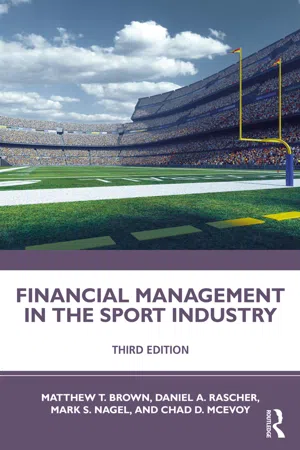
Financial Management in the Sport Industry
- 658 pages
- English
- ePUB (mobile friendly)
- Available on iOS & Android
Financial Management in the Sport Industry
About this book
Now in a fully revised and updated third edition, this essential textbook introduces the fundamentals of sport finance and sound financial management in the sport industry. It is still the only textbook to explain every aspect of finance from the perspective of the sport management practitioner, explaining key concepts and showing how to apply them in practice in the context of sport.
The text begins by covering finance basics and the tools and techniques of financial quantification, using industry examples to apply the principles of financial management to sport. It then goes further, to show how financial management works specifically in the sport industry. Discussions include interpreting financial statements, debt and equity financing, capital budgeting, facility financing, economic impact, risk and return, time value of money, and more. The final part of the book examines financial management in four sectors of the industry: public sector sport, collegiate athletics, professional sport, and international sport. It provides an in-depth analysis of the mechanics of financial management within each of these sport sectors. Useful features, such as sidebars, concept checks, practice problems, case analysis and case questions will help students engage more deeply with financial techniques and encourage problem-solving skills. This new edition includes a completely new chapter on international sport, reflecting the globalized nature of the modern sport industry, as well expanded coverage of current issues such as digital media finance, recent legal cases affecting collegiate sport, and the central importance of collective bargaining.
Financial Management in the Sport Industry is an essential textbook for any undergraduate or postgraduate course in sport finance, and an invaluable supplement to any course in sport business or sport management. It is also an important reference for all sport management practitioners looking to improve their understanding of finance.
The book is accompanied by updated and expanded ancillary materials, including an instructor's manual, PowerPoint slides, and an image bank.
Frequently asked questions
- Essential is ideal for learners and professionals who enjoy exploring a wide range of subjects. Access the Essential Library with 800,000+ trusted titles and best-sellers across business, personal growth, and the humanities. Includes unlimited reading time and Standard Read Aloud voice.
- Complete: Perfect for advanced learners and researchers needing full, unrestricted access. Unlock 1.4M+ books across hundreds of subjects, including academic and specialized titles. The Complete Plan also includes advanced features like Premium Read Aloud and Research Assistant.
Please note we cannot support devices running on iOS 13 and Android 7 or earlier. Learn more about using the app.
Information
PART I
Finance Basics
Chapter 1
Introduction to Sport Finance
KEY CONCEPTS
INTRODUCTION
Table of contents
- Cover
- Half Title
- Title Page
- Copyright Page
- Contents
- Contributor Biographies
- Glossary
- PART I Finance Basics
- PART II Financial Management
- PART III Application of Financial Management in Sport
- PART IV Financial Attributes of Select Sport Industry Segments
- Appendix
- Index